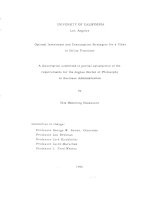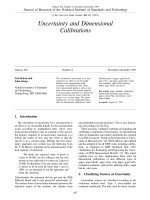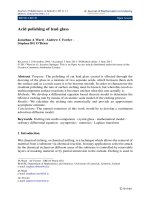Journal of Business Case Studies – November/December 2009 Volume 5, Number 6 13 An Apparel Brand‘s Channel Strategy: The Case of Oliver in Korea
Bạn đang xem bản rút gọn của tài liệu. Xem và tải ngay bản đầy đủ của tài liệu tại đây (446.5 KB, 10 trang )
Journal of Business Case Studies – November/December 2009 Volume 5, Number 6
13
An Apparel Brand‘s Channel Strategy:
The Case of Oliver in Korea
Hyejeong Cho, Sungkyunkwan University, South Korea
Yanghun Lim, Sungkyunkwan University, South Korea
Sungmin Ryu, Ph.D*, Sungkyunkwan University, South Korea
ABSTRACT
The purpose of this case study was to describe the development of a channel strategy for an
apparel brand, BoKids, designed to distribute its brand, Oliver, efficiently to customers. Bokids
launched its childrens’ apparel brand, Oliver, in Korea by signing a brand license contract with
Oliver of USA. When the brand was launched in 2005, Oliver was positioned as a brand with a
reasonable price and a high quality product, which was sold primarily through department stores.
In 2007, Oliver was suffering from sluggish sales volumes, and switched its main distribution
channel from department stores to discount stores, which are the number 1 retail format in Korea.
Oliver was compelled to adjust the price range of its main products to $20 – 30 in order to satisfy
the needs of discount store customers. However, Oliver has considered Internet shopping as
another channel for the Oliver brand, as Internet shopping is rapidly gaining popularity in Korea.
This case can be used in conjunction with discussions on marketing topics, such as the design of
marketing channels (Chapter 6, Designing the Marketing Channel, “Marketing Channels: A
Management View,” 7
th
Edition by Bert Rosenbloom, South-Western College Pub, 2007) for senior
level marketing seminars.
Keywords: Marketing Channels, Channel Design, Retailer types
INTRODUCTION
okids launched its kids‘ apparel brand, Oliver, in Korea by signing a brand license contract with Oliver
of USA, a world famous kids‘ apparel brand. Oliver of USA boasts 90-years of history, and has been
recognized as the No. 1 kids‘ apparel brand with high-quality products as well as very reasonable prices.
Bokids‘ Oliver in Korea (hereafter referred to as Oliver) introduced strategically planned products, developed
natural materials providing comfortability and durability, and operated a just-in-time production system.
Upon its launch in 2005, Oliver was positioned as a reasonably priced and high-quality brand, which was
sold primarily in department stores. However, Oliver decided to cut its prices by 15-20% in December of 2005, as its
prices were deemed to be higher than those of its competitor brands in department stores. In line with the price cut,
the company decided to expand its direct import line, from 5% to 30% of total sales.
In October 2006, Oliver re-positioned itself as a denim-specialty brand and expanded its denim line, one of
the strong points of the brand. Additionally, Oliver transformed its organization from a brand license-based
production to a direct import company in order to reinforce its brand originality. While expanding its denim line,
Oliver reduced the size of its infant line, and reset its main target group to the 4-8 year old age group.
In 2007, Oliver switched its main distribution channel from department stores to discount stores, and
adjusted the price range of its primary products to $20 – 30, in an effort to conform to discount store customers‘
budgets. As Oliver changed its focus to direct imports, it implemented a cost-saving sourcing system through the
direct importation of products from the production site in China rather than importing from the headquarters in the
United States. The company also implemented a direct order system from overseas production sites to adjust the
design and fit when the design and materials were not concordant with the demands of the domestic market.
As the result of changes in product position and channel strategies, Oliver is faced with the need to
overhaul its channel strategy and select relevant distribution outlets. Lots of apparel brands are diversifying their
distribution channels in order to cope with department stores‘ absurd requests—i.e. unreasonably high sales
commission rates. Among outlets, such as department stores, discount stores, franchise shops, and Internet shopping,
Oliver should select the proper combination of distribution outlets in order to efficiently distribute its clothes to
customers.
* Contact Author
B
Journal of Business Case Studies – November/December 2009 Volume 5, Number 6
14
CURRENT SITUATION OF APPAREL DISTRIBUTION IN KOREA
Total apparel and fashion market size is expected to reach $21 billion in 2007, a 3.7% year-on-year growth.
Consumption recovery was delayed in the first half of 2007 due to the strength of the Korean Won against the US
dollar, in addition to high oil prices. In the second half of 2007, consumption appeared to have recovered to some
degree, as indicated by the increase in the consumer expectation index to over 100, principally as the result of a
bullish stock market, economic recovery, and improved household expectations for the economy (see Table 1).
Table 1: Market Size and Growth Rate of Apparel Sales
Source: Daishin Securities Co, Hana institute of finance
It is indicated that the portion of infants and children‘s wear has been on the increase in Korea‘s fashion
market. As presented in Table 2, infant and children‘s wear took 36.8% of the total fashion market in 2008 which
increased 33.1% from 2007. Whereas it shows that the other apparel categories including sportswear, character
casual, and ladies‘ wear have decreased.
Table 2: Ratio Changes Per Clothing Type
Source: Korean Textile Industry Association
The most visible changes in Korean channels of distribution are the increasing market shares of discount
stores, and the rise of Internet shopping. These two channels have stolen the market share of previously dominant
Journal of Business Case Studies – November/December 2009 Volume 5, Number 6
15
channels, most notably department stores and traditional street vendor markets.
As shown in Table 3, discount stores and outlets recorded robust sales growth, which has altered the
rankings of each of these distribution channels. Discount store sales already exceed those of department stores, and
the gap between these two channels has widened.
Department stores have recently recorded very slow sales growth and now command the second-largest
market share of distribution channels in Korea. Internet-based distribution channels are expected to surpass
department stores soon in terms of the 2008 market share. Discount stores are responsible for the preponderance of
market share, whereas the traditional street vendor market and others are showing negative sales growth.
Table 3: Market Share of Main Retail Distribution Channels in 2007
In Trillion Won 2005 2006 2007 YoY sales growth 07
Traditional Street Vendor
Market
88.0 86.8 85.0 -2.2%
Department Store 17.2 17.9 18.7 4.5%
Discount Store 23.6 25.4 27.7 9.1%
Mail Order TV Home
Shopping
1.7 4.5 4.8 6.7%
Internet 10.7 13.1 15.9 21.4%
Factory Outlets 4.6 5.2 5.9 13.0%
Source: Shinsaegae Distribution Research Institute, Korea National Statistics Office
Department Store
In Western countries, department stores make profits through the difference between the price they pay to
their suppliers and the price at which they sell the product to their customers. The majority of the famous department
stores in the United States and European countries purchase all kinds of products from designers and makers, and
sell the products to customers by adding appropriate margins to them. Thus, they develop a variety of marketing
tools to increase sales volume, and implement their own inventory process systems.
Department stores in Korea make money principally by renting space to suppliers. Usually, they establish a
sales commission, which is 35-40% of the sales price brand suppliers demand from consumers. Those sales
commissions account for 80-90% of department stores‘ sales. Korean department stores depend solely on the sales
commissions paid by brand suppliers resulting in constant issues of excessive commissions charged to weak brand
suppliers.
Department stores have exercised their absolute power on apparel brand suppliers, as they are one of the
principal distribution channels for apparel brand suppliers. Therefore, there have been some cases of unfairness and
wrongdoing on the part of department stores. Department stores force brand suppliers to pay very high sales
commissions and to share additional costs. For instance, apparel suppliers have complained about absurdly high
sales commissions, as well as a variety of sales event participation fees, including enforced-sales, shared advertising
costs, product renewal costs, etc. (see Table 4 below). The problem is that those high commissions actually raise the
retail price.
Table 4: Department Stores’ Injustice Business Practices
Type Case
Type1 Transferring costs to
brand suppliers
- Transferring costs occurred by department stores‘ promotion events
Type2 Enforcing to take loss - Enforcing brand supplier to take loss caused by department store‘s mistake to
put wrong price tag
- Pushing brands to participate in department store‘s promotion
Type3 Entertainment cost - Department stores‘ purchasing managers force brand suppliers to treat them.
Source: The Hankyorah Newspaper, 11/10/2006
Journal of Business Case Studies – November/December 2009 Volume 5, Number 6
16
Discount Stores
Discount stores are looming as a next-generation channel for the apparel industry, as they reinforce the
fashion business while attempting to change them into ―lifestyle stores‖. Although there is fierce competition among
apparel brands in discount stores, apparel brands still attempt to launch brands for discount stores. This is
attributable primarily to the fact that approximately seven new brands launch every new season, and discount stores
are often considered the main distribution channel for these new brands. Brands that rely primarily on department
stores are also constantly attempting to increase their sales share in discount stores.
Discount stores also charge 15-20% sales commissions to apparel brands for renting fees. As discount
stores request lower sales commissions than do department stores, apparel brands tend to rely more heavily on
discount stores than department stores. All apparel brands, including women‘s, men‘s, casual, and sports apparel
brands are desperately attempting to enter the discount store market. Discount stores are, therefore, increasing their
market share of apparel sales and have evidenced the highest levels of sales growth in the past couple of years. This
is why discount stores compete with department stores to become a principal channel for kids‘ apparel.
As consumers are attracted by the relatively low prices of discount stores, there is an increasing demand for
discount store space. Because approximately seven new brands are launched every new season, the demand for
discount store space continually rises. The problem with this is that competition among kids‘ apparel brands
becomes severe, which results in a high commission rate for kids‘ apparel brands in discount stores. Discount stores
emulate, to some degree, the bad behavior engaged in by department stores. Discount stores tend to charge high
sales commissions, as do department stores. They also engage in the chronic unjust practices associated with
department stores, including high sales commissions, sharing the labor costs of the sales staff, and various types of
promotion costs. In addition to sales commissions, the discount store requests brand suppliers to pay logistics costs
and to share the labor cost of part-time sales staff. Thus, the total charges levied by discount stores accounts for
almost 30% of total sales volume.
Another unjust business practice of discount stores is that, although they purchase and sell the products
under their own responsibility, they are not responsible for the inventory of apparel brands. Discount stores pretend
to undertake inventories, but they actually force the apparel brand supplier to accept unsold products. They transfer
the entirety of the inventory burden to brand suppliers. For example, if they require 100 items, they order 200 items
and simply return inventory goods after the season passes. According to the brand suppliers, some foreign-
franchised discount stores purchase goods for credit and delay payments in order to deduct various costs afterwards.
Discount stores‘ best competitive edge is their low prices. As such, their sales prices cannot exceed 3-3.5
times the manufacturing cost. Considering their frequent sales promotion events, it has been estimated that discount
stores cannot make profits if they continue to increase sales commissions. Taking into account sales commissions of
25%, intermediate management commissions of 15%, manufacturing costs of 30% and constant discount rates of 5%,
brand suppliers‘ profitability hovers around 25%. However, considering factors such as the over 50% promotion
event rates and inventory rates, brand suppliers tend to experience difficulties in making profit.
Internet Channel
Because Internet selling was so severely hit by the burst of the ―dotcom bubble‖ at the end of 1990, it has
been reborn as a reliable distribution channel. The Internet has developed into one of the major global distribution
channels, and has good future prospects in Korea.
The internet channel recorded a 29.5% year-on-year average sales growth in Korea between 2001 and 2007,
primarily due to the fact that Korea boasts the world‘s highest internet broadband penetration. Since the system was
stabilized in 2003, the internet channel enjoyed a 22.3% year-on-year average sales growth, reaching a total market
size of $15 billion in 2007.
Consistent with the growth of the overall internet channel, Internet apparel sales enjoyed a 57.8% year-on-
year sales growth during the period between 2001 – 2007. Coupled with general sales growth, the contribution of
apparel sales to the total internet channel expanded from 5.3% in 2001 to 17.2% in 2007, and this trend is expected
to continue until 2010. According to the National Retail Federation, apparel on-line sales caught up with computer
on-line sales in 2006, after travel on-line sales surpassed computer on-line sales. . ( see Table 5 below)
Journal of Business Case Studies – November/December 2009 Volume 5, Number 6
17
Table 5: Apparel Sales Volume in Internet
source: Korean Statistical Information Service
Even though the contribution of the internet channel to the total kids‘ apparel market is not overly large, the
internet channel for kids‘ apparel is growing. Kids‘ apparel sales on the internet have increased actively at an
average growth rate of 15% per year. As internet channels offer inexpensive prices, young parents who are relatively
poor tend to prefer to use internet channels. Another advantage of the internet channel for kids‘ apparel is that it is
generally easier to establish the fit of kids‘ apparel than to do so for adult apparel. Kids‘ apparels are also not
restricted to fit, which is not the case with adult apparel.
However, the internet channel also has its inherent disadvantages. Apparel brand suppliers must bear a
huge inventory due to returned goods. In particular, the return rate for apparels has been reported to be as high as
30%. In extreme cases, customers have returned clothes after wearing them on several occasions, and companies
must dispose of this used clothing.
Franchise
Franchise is one of the main channel for the sales and distribution of kids‘ apparel. Many kids‘ apparel
brands face intense competition in discount stores, and suffer from the extremely low price policies of the discount
store. Thus, apparel brands with high quality brands launch franchises because they experience difficulties in
attempting to emulate the low price policies of the discount stores. Therefore, higher-priced brands tend to rely more
heavily on franchises.
Kids‘ apparel brands are recruiting franchise dealers as an alternative to cope with declining department
store sales. As department stores are currently suffering from low overall sales growth, higher-priced brands have no
real choice but to rely more on franchises than before.
Relatively new brands such as ‗Our Q Junior‘ with 84 shops, ‗Marueye‘ with 45 shops, and ‗Oceansky‘
with 55 shops, are actively opening franchise shops. These new brands tend to open their franchise shops in
downtown areas of suburb cities like Wonju, Bupyung, and Cheonan, enjoying higher margins than other
established brands. In addition, these new brands complement their weaknesses as market followers by offering
differentiated commission rates based on franchisees‘ careers and shop locations. After opening shops, brands
increasingly support promotion activities, supplying popular basic items, affluent event items, and promotion gifts.
Kids‘ apparel franchisees have been directly hit by the overall economic slowdown, as well as the
extremely low-priced goods supplied by discount stores. Kids‘ brands have experienced difficulties in dealing with
the reduction in sales of their franchise shops. In particular, they have feuded with franchisees as they have
increased the price of their goods.
While infant apparel sales have expanded significantly recently as the result of increased marriage rates and
birth rates, kids‘ apparel sales volumes accounted for only 3.7% of total apparel sales this year, which represents a
0.1% point increase from last year. As Korean households increase their education expenditures, they have reduce









